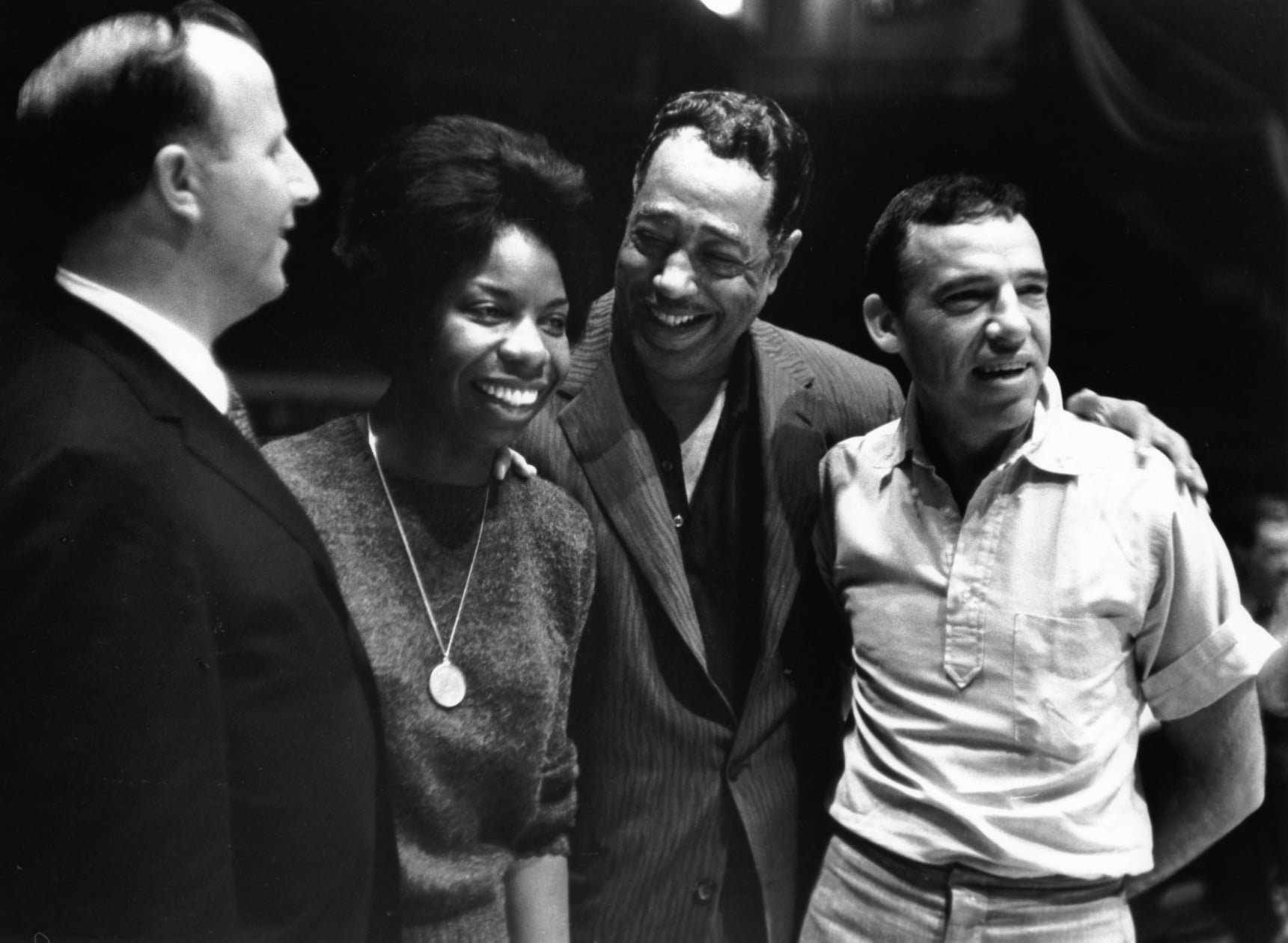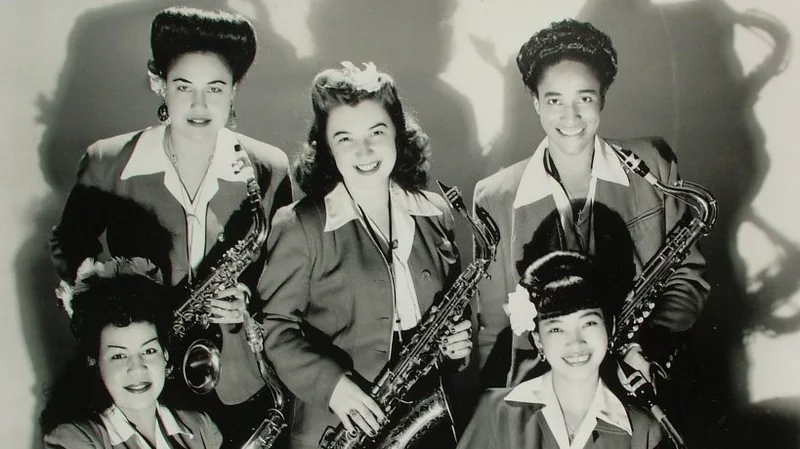
George Shearing, Nina Simone, Duke Ellington and Buddy Rich, at the Madison Square Garden Jazz Festival in New York, in 1959. Photo: Herb Snitzer /MICHAEL OCHS ARCHIVE/GETTY
Sure, pianist George Shearing (pictured, above left) was literally blind, to color and everything else (and once made an album with all three Black Montgomery brothers –Wes, Buddy and Monk). Nevertheless, this photo – which prompted this brief essay – signifies, for me, the pan-racial solidarity of jazz as a social model, including brash, super-egotistical Buddy Rich — in 1959. 1
I’m no Rich expert but, a cursory examination of his noteworthy 1967 album Speak No Evil, reveals how integrated his sensibilities and practices were by then. The title tune is by the great African-American saxophonist composer Wayne Shorter. The album also includes compositions by black artists Earth, Wind and Fire; Natalie Cole; The Pointer Sisters; and The Isley Brothers. His band at the time featured these black musicians: arranger Richard Evans, piano soloist Kenny Barron, bassist Bob Cranshaw, tuba player Howard Johnson, and vocalist Retta Hughes. Speak no evil, indeed.
There were certainly plenty more of integrated jazz bands by 1967, but let’s especially note examples of pioneering pre-’60s white bandleaders whom one might assume could travel and work easier in racially charged regions of America without the “white man’s burden” which is actually “the black man’s burden,” (as author/editor Greg Tate has eloquently documented 2.) of conforming to societal restrictions on integration, and thus helped advance the burgeoning civil rights movement.
The integration saga begins with Benny Goodman who hired star soloists from the Ellington and Basie Orchestras for 1938 at his epic Carnegie Hall concert, and his contemporary quartet with pianist Teddy Wilson and vibist Lionel Hampton. Earlier in the ’30s, he’d hired Billie Holiday, Coleman Hawkins, and arranger Fletcher Henderson. In the ’40, Goodman hired guitarist Charlie Christian, trumpeter Cootie Williams, and saxophonist Wardell Gray.
Among notable 1950s Latin and Afro-Cuban jazz musicians and bands and musicians were Chano Pozo, Machito, Chico O’Farrell, Tito Puente, Mongo Santamaria, Cal Tjader, Prez Prado, Astor Piazolla, Xavier Cugat, singer Harry Belafonte and, yes, that the eclectic Brit George Shearing.
Then in the ’50s, among the most noatable integration developments came from Milwaukee-native and big band leader Woody Herman. He hired a variety of African American musicians in the 1950s, including vibraphonist Milt Jackson, trumpeters Ernie Royal, Reunald Jones, Nat Adderley, and Howard McGee, and bassists Keter Betts and Major Holley bass. Charlie Parker was guest soloist with the band in early ’50’s.
Herman also hired (white) trumpeter-singer Billie Rogers, one of the first female instrumentalists in a male-dominated band who wasn’t a singe or pianist. *
Speaking of women, in the 1940s, we can’t forget the integrated all-woman big band The International Sweethearts of Rhythm.

The saxophone section of the 1940s tri-racial orchestra The International Sweethearts of Rhythm Courtesy Rosalind Cron
Besides Shearing, Herman and Buddy Rich, integrated bands with white leaders included The Dave Brubeck Quartet, Lennie Tristano, Art Pepper, The Gerry Mulligan Quartet, Stan Getz, the black and white co-leadership and integrated personnel of the standard-setting Thad Jones-Mel Lewis Orchestra and The J.J. Johnson-Kai Winding Quartet.
Among integrated black leaders of the late 1950s: Miles Davis (famously on Birth of the Cool, and Kind of Blue), Charles Mingus, Ornette Coleman, 3 John Coltrane, George Russell, Sarah Vaughan and Bud Powell, who recorded with Buddy Rich back in 1951.
Also, pioneering Black pianist-composer Mary Lou Williams worked with white trombonist Jack Teagarden, and had arranger Milt Orent assist in arrangements for her ambitious 1940s Zodiac Suite.
I know I am forgetting other “integral” leaders from both races.
l’ll just touch lightly on matters of early modern jazz “influence.” Bebop rose as a virtuosic, self-consciously Black-innovated style (like most all major jazz idioms) to deter whites from “stealing” and profiting by mimicking and marketing their style — as happened profligately with swing. Still, bop had a few notable Bud Powell-influenced white pianists, such as Dodo Mamarosa, Joe Albany, and Al Haig. Among 1950s white pianists influenced by Thelonious Monk (and perhaps Herbie Nichols) was the tragically-short-lived Richard Twardzik. 4.
Perhaps an efficient way to enhance and conclude this brief historical integration story is to note the 1950s phenomenon of “cool jazz,” and here I’m plucking straight from Wikipedia, to dispel the notion this popular genre was the exclusive realm of white West Coast musicians: “Some observers looked down upon West Coast jazz because many of its musicians were white, and because some listeners, critics, and historians perceived that the music was too cerebral, effete, or effeminate, or that it lacked swing.[12][13][14] However, African American musicians played in the style, including Curtis Counce, John Lewis, Chico Hamilton, Harry “Sweets” Edison, Buddy Collette, Red Callender, Harold Land, Eugene Wright and Hampton Hawes.”
__________
* Thanks to Curt Hanrahan, music director of The Milwaukee Jazz Orchestra, for information on Woody Herman.
- Thanks to my good friend, Stephen Braunginn, formerly jazz program host of WORT-FM radio in Madison, and of the Jazz Enthusiasts Facebook group, for posting this photo (at top).
- Everything but the Burden: What White People Are Taking From Black Culture, edited by by Greg Tate, Broadway Books 2003. This book addresses what is now known in P.C. terms as cultural appropriation. But it seems to me that white jazz artists who cover and pay royalties to black composers, and who fairly hire black musicians are, as Spike Lee would put it, “doing the right thing.”
- Though most famous for his piano-less “free jazz” Ornette Coleman used white pianists on his important earliest recordings, the Live at the Hillcrest date with Paul Bley (a true quiet giant) and Walter Norris on Coleman’s Contemporary label recordings, recently re-released as a 2-CD box set.
- Twardzik’s composition “Yellow Tango,” is a Latin-flavored small masterpiece of offbeat jazz, well represented on The Chet Baker Quartet featuring Dick Twardzik Live in Koln.

